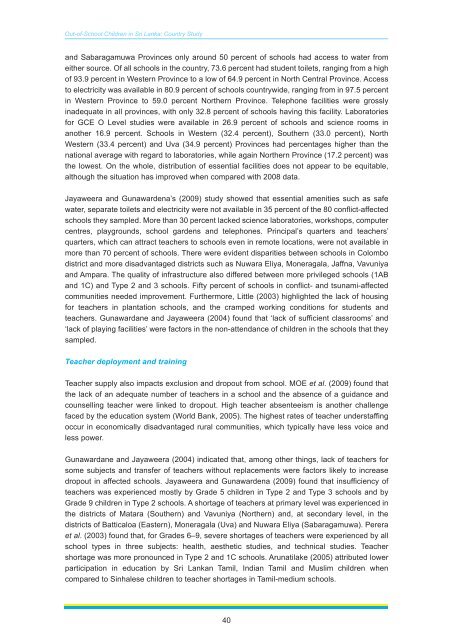Sri Lanka - Institut de statistique de l'Unesco
Sri Lanka - Institut de statistique de l'Unesco
Sri Lanka - Institut de statistique de l'Unesco
Create successful ePaper yourself
Turn your PDF publications into a flip-book with our unique Google optimized e-Paper software.
Out-of-School Children in <strong>Sri</strong> <strong>Lanka</strong>: Country Study<br />
and Sabaragamuwa Provinces only around 50 percent of schools had access to water from<br />
either source. Of all schools in the country, 73.6 percent had stu<strong>de</strong>nt toilets, ranging from a high<br />
of 93.9 percent in Western Province to a low of 64.9 percent in North Central Province. Access<br />
to electricity was available in 80.9 percent of schools countrywi<strong>de</strong>, ranging from in 97.5 percent<br />
in Western Province to 59.0 percent Northern Province. Telephone facilities were grossly<br />
ina<strong>de</strong>quate in all provinces, with only 32.8 percent of schools having this facility. Laboratories<br />
for GCE O Level studies were available in 26.9 percent of schools and science rooms in<br />
another 16.9 percent. Schools in Western (32.4 percent), Southern (33.0 percent), North<br />
Western (33.4 percent) and Uva (34.9 percent) Provinces had percentages higher than the<br />
national average with regard to laboratories, while again Northern Province (17.2 percent) was<br />
the lowest. On the whole, distribution of essential facilities does not appear to be equitable,<br />
although the situation has improved when compared with 2008 data.<br />
Jayaweera and Gunawar<strong>de</strong>na’s (2009) study showed that essential amenities such as safe<br />
water, separate toilets and electricity were not available in 35 percent of the 80 conflict-affected<br />
schools they sampled. More than 30 percent lacked science laboratories, workshops, computer<br />
centres, playgrounds, school gar<strong>de</strong>ns and telephones. Principal’s quarters and teachers’<br />
quarters, which can attract teachers to schools even in remote locations, were not available in<br />
more than 70 percent of schools. There were evi<strong>de</strong>nt disparities between schools in Colombo<br />
district and more disadvantaged districts such as Nuwara Eliya, Moneragala, Jaffna, Vavuniya<br />
and Ampara. The quality of infrastructure also differed between more privileged schools (1AB<br />
and 1C) and Type 2 and 3 schools. Fifty percent of schools in conflict- and tsunami-affected<br />
communities nee<strong>de</strong>d improvement. Furthermore, Little (2003) highlighted the lack of housing<br />
for teachers in plantation schools, and the cramped working conditions for stu<strong>de</strong>nts and<br />
teachers. Gunawardane and Jayaweera (2004) found that ‘lack of sufficient classrooms’ and<br />
‘lack of playing facilities’ were factors in the non-attendance of children in the schools that they<br />
sampled.<br />
Teacher <strong>de</strong>ployment and training<br />
Teacher supply also impacts exclusion and dropout from school. MOE et al. (2009) found that<br />
the lack of an a<strong>de</strong>quate number of teachers in a school and the absence of a guidance and<br />
counselling teacher were linked to dropout. High teacher absenteeism is another challenge<br />
faced by the education system (World Bank, 2005). The highest rates of teacher un<strong>de</strong>rstaffing<br />
occur in economically disadvantaged rural communities, which typically have less voice and<br />
less power.<br />
Gunawardane and Jayaweera (2004) indicated that, among other things, lack of teachers for<br />
some subjects and transfer of teachers without replacements were factors likely to increase<br />
dropout in affected schools. Jayaweera and Gunawar<strong>de</strong>na (2009) found that insufficiency of<br />
teachers was experienced mostly by Gra<strong>de</strong> 5 children in Type 2 and Type 3 schools and by<br />
Gra<strong>de</strong> 9 children in Type 2 schools. A shortage of teachers at primary level was experienced in<br />
the districts of Matara (Southern) and Vavuniya (Northern) and, at secondary level, in the<br />
districts of Batticaloa (Eastern), Moneragala (Uva) and Nuwara Eliya (Sabaragamuwa). Perera<br />
et al. (2003) found that, for Gra<strong>de</strong>s 6–9, severe shortages of teachers were experienced by all<br />
school types in three subjects: health, aesthetic studies, and technical studies. Teacher<br />
shortage was more pronounced in Type 2 and 1C schools. Arunatilake (2005) attributed lower<br />
participation in education by <strong>Sri</strong> <strong>Lanka</strong>n Tamil, Indian Tamil and Muslim children when<br />
compared to Sinhalese children to teacher shortages in Tamil-medium schools.<br />
40

















